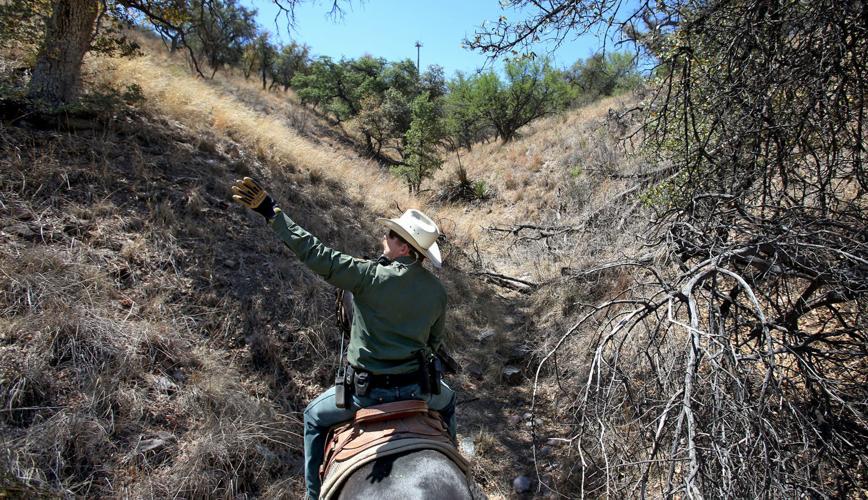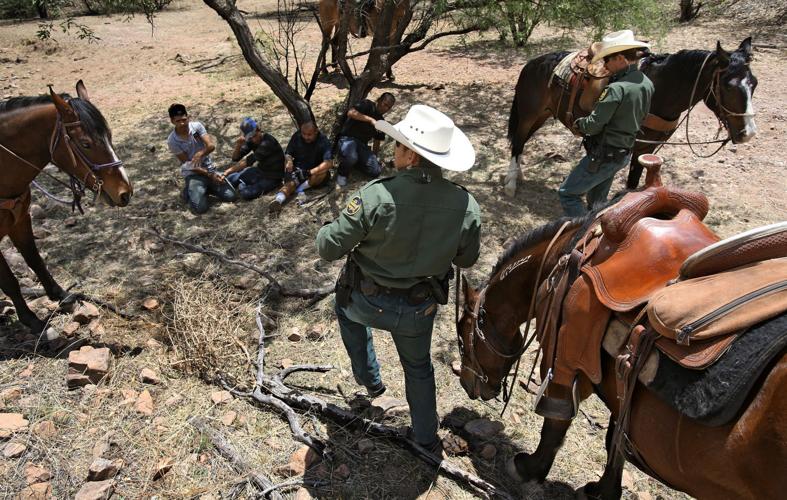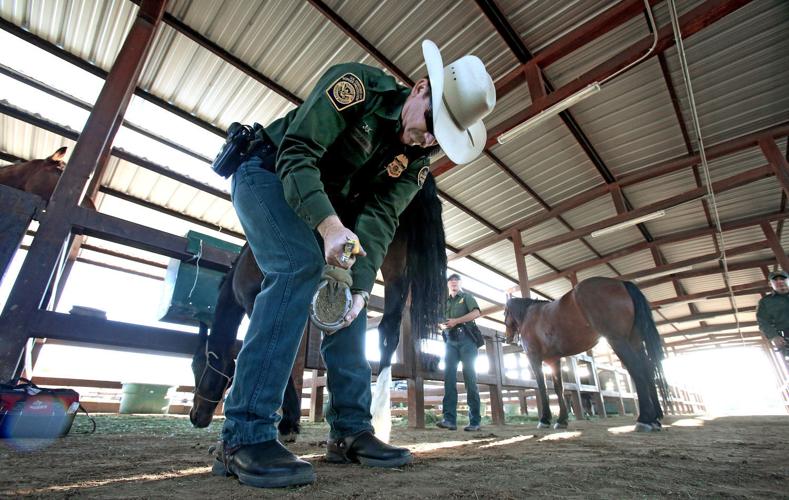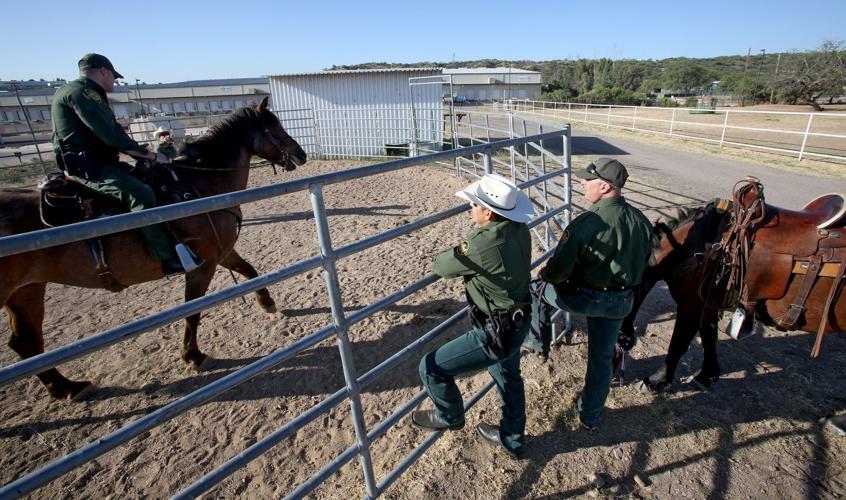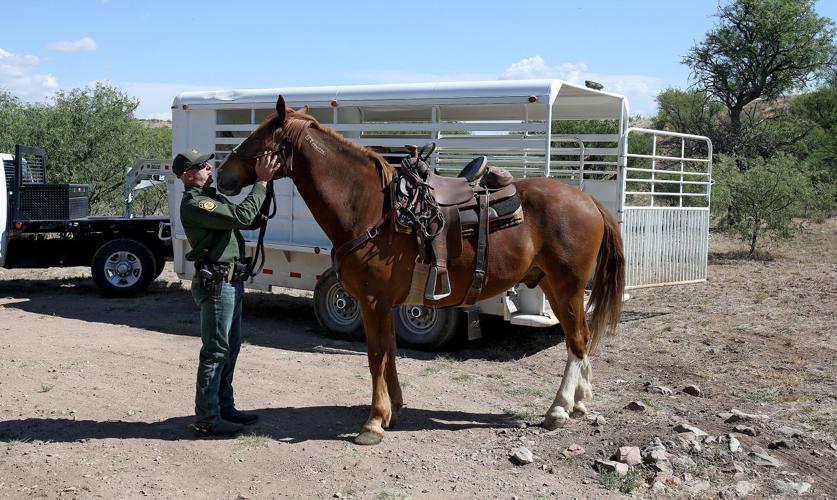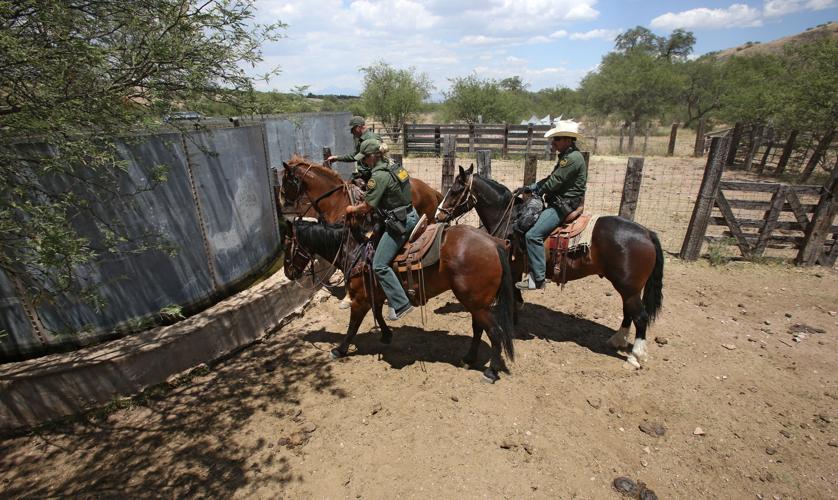At the base of a wheat-colored knoll, partially shielded by scrub oaks and thorny bushes, Shawn Rodgers is about to unleash Mayhem.
Aided by digital technology and a complete knowledge of his surroundings, Rodgers, at the appointed moment, gives the dark bay horse his head and the 6-year-old mustang springs up the hill, rocks and dust flying as he gallops forward, brushing by trees, crushing dried branches and anything else in his path.
Seconds later, in a coordinated maneuver, Rodgers and fellow members of the U.S. Border Patrol’s Nogales Station Horse Patrol Unit are upon four surprised border crossers a short distance north of the Sonora-Arizona border, just west of Nogales.
As he closes in on some of the men who are making a run for it in the steep, slippery terrain, Rodgers, a supervisory Border Patrol agent, yells out, “Dónde vas? Tenemos caballos,” letting the men know they are being pursued by patrolmen on horseback.
Such an announcement, Rodgers says later, helps people realize they should stop running because they cannot outrun a horse.
In short order, the four men are rounded up and told to sit in the shade of a tree where they are questioned and searched for identification, weapons and contraband. Their money is counted and documented.
It is also a good time to identify the foot guides, or smugglers, because that’s important to a successful prosecution, Rodgers said.
The encounter with the border crossers at that spot was not coincidental.
“Our operations are intelligence-based and rely heavily on information, traffic trends and all the technology available to us,” he said.
Border cameras and sensors give the agents an idea of the crossers’ entry point, and their experience indicates the likely routes that they may take.
Hand-held radios let agents on the ground keep in contact with those who are monitoring the changing situation.
Because of technology, the areas where the mounted agents are deployed can vary daily and even in mid-shift to address changes throughout the day, Rodgers said.
Coupled with the agents’ knowledge of the area, it puts them in the best position to stop any illegal traffic or threat.
“We can rapidly and appropriately adjust to address any incursions in the Nogales Area of Operation,” he said.
Plus, they can work hand-in-hand with other ground units, including agents riding ATVs .
But the quick interception of the crossers is also where the agency’s mustangs come in.
An agent on horseback can cover more ground in less time than an agent on foot, Rodgers said.
There is also the tactical advantage of being mounted and high above the ground, which makes it easier to see things.
And of course, a horse is much quieter than a truck or ATV, he said.
And a horse’s keen sight and hearing allow it to alert agents to the presence of people often before the agents can hear or see the group themselves, he said.
The horse, as a piece of technology, is not new to the Border Patrol.
When the agency began in 1924, in order to join the agency, an applicant needed two meet to requirements, one of which was owning a horse, said Bobbi Schad, the Tucson Sector horse patrol coordinator.
The other requirement was a gun, Schad said. The government would provide the ammo.
Now there are between 14 and 22 horses assigned at the Nogales Border Patrol Station alone, she said.
The horse units are assigned to the rural mountainous areas, ranch lands and those areas that are environmentally sensitive, Schad said. They work closely with local ranchers, who are a vital source of information, and in return, the agents tell ranchers about sick or injured cattle, downed fences or broken wells.
Statewide, there are currently 90 mustangs in use, and nine other Border Patrol sectors also use them , Schad said.
Not all mounts are mustangs. Some are purchased from the general public, local rescue groups and, occasionally, some are donated. They all must meet the agency’s requirements, and any horses purchased must be at a low price, she said.
Agents who want to join the unit must be certified and go through a thorough training.
And although there are 90 agents currently assigned to the horse units in the Tucson Sector, several hundred agents have gone through the training and are certified to be in the horse patrol, Schad said.
The unit’s apprehension numbers for this past June say a lot about its efficiency , Schad said.
“For the month of June, the horse patrol units within the Tucson Sector apprehended around 400 subjects and seized approximately 2,900 pounds of marijuana,” she said.
Back in the shade, Rodgers and Schad, along with several other agents and Mayhem, wait calmly as they hold the four border crossers until a vehicle can come for them.
Otherwise, the agents would have to walk them to the nearest road.
Luckily, a dirt road is nearby, and once the crossers are picked up, the agents find their way back to the horse trailer, with a brief stop for water at a well to refresh the horses for the journey back.


